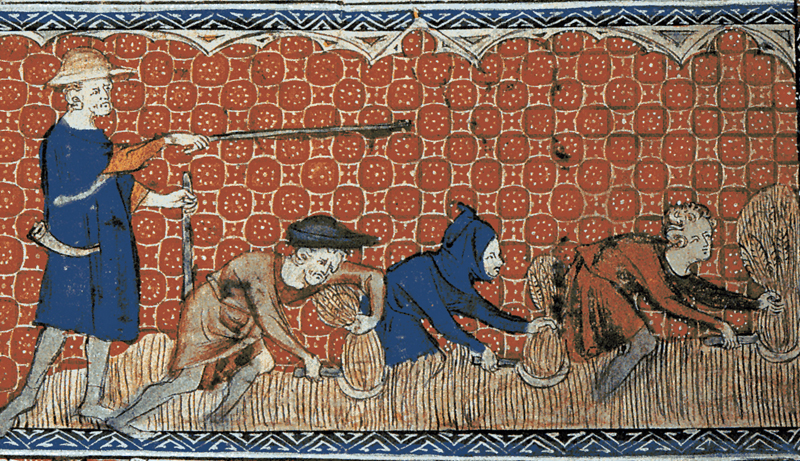Feudalism: A thing of the past?

A short review of the history of feudalism in the Middle Ages is insightful for the inheritance debate in two very different ways. On the one hand, we can see historical feudalism as a prime example of inherited privilege, which may lead us to perceive today’s system of inherited privilege as a continuation or revival of feudalism. On the other hand, feudalism is also the birthplace of one of the most powerful tools we have at hand against inherited (economic) privilege: inheritance tax or feudal relief, as it is mostly referred to in the context of feudalism.
The essence of feudalism
Though a debated concept among historians, Feudalism refers to a certain political and economic system prevalent in Europe in the Middle Ages between 9th and 15th centuries. Feudalism, alongside Christianity, can be regarded as the most essential institution of the Middle Ages in Europe. It differed from the two precursing forms of governments (republics and autocracies) primarily through its indirect, mediated government through many layers of fiefs, which made it a decentralised, cellular and – perhaps as a result – stable system.
It’s most often associated with specific key characteristics[1]:
- Disintegration: Feudalism as a political and economic system arose in Europe following the fall of Rome. Feudalism was not the reason for Rome’s fall (suffering from other internal and external pressures such as over-spending and ‘barbarian’ attacks). Still, it contributed to the disintegration of centralised power and the monopoly of violence.
- Decentralised, indirect rule: Feudalism comprised a hierarchic, multi-layer system of rights and obligations (the fiefs). On top of the pyramid was the king, granting rights and obligations to its vassals (the nobility and clergy), which engaged further subvassal-relationships, and so on.
- Property Rights: Fiefs can be regarded as an early form of property rights (land ownership) granted by the lord to the man or vassal (e.g. the king to a nobleman or bishop). Through inheritance and purchase, a vassal could accumulate multiple fiefdoms over time. Serving more and more masters at the same time, the personal bond character of fiefdoms decreased. It became more and more a commodified private property.
- Conditionality and Pactism: Fiefs as property rights were not absolute but conditional on mutual loyalty, military service, labour, and taxes. Because of these mutual obligations (which can be perceived as a kind of pact between ruler and ruled, hence the name pactism), feudalism paved the way for a general spread of contractual agreements (e.g. in commerce) and the notion of accountability of the ruler.
- Revocability (1st feudal age): Originally, fiefs were granted for a life time only, and could be re-assigned upon death to a new vassal from the direct network of the lord. In this era, fiefs expressed strong personal bonds and relations between lord and vassal, and a vassal usually only had one lord.
- Inheritance (2nd feudal age): Later, fiefs could be inherited against feudal relief payment by the heir, an early form of inheritance tax. Inheritance of privilege happened along noble lineage.
- Dynasties: When fiefs were no longer revocable but became inherited, aristocratic families transmitted wealth and power along dynastic succession structures.
- Violence and Poverty: Feudalism is infamous for its constant violence and low economic growth. The latter may be caused by the threat of destruction and plunder, which made economic investments unattractive.
The decline of feudalism
Feudalism in Europe ended with the rise of the nation states (which centralised public power again), the rise of city-driven commerce and the democratic revolutions. In the case of the French Revolution, it formally ruled-out the last legal left-overs of feudalism.
Feudalism can be perceived as a process of disintegration and decentralisation of the legacy of the Roman Empire up to a point where there was no public authority securing law-and-order. There was no monopoly of violence but instead rivalling dynasties and lordships, which became “predatory, militant, aggressive and unconstructive”[2]. The constant violence meant that commerce suffered, as incentives to work hard and invest were limited due to risk of plunder. The economy was in a ‘violence trap’.[3] Only the church, the other second major force of the Middle Age, tried more or less successfully to maintain some level of centralised authority against the disintegrative forces of feudalism.[4]
In the late Middle Ages, the decentralised system of strong feudal lords was under pressure from two sides: Kings managed to regain power, differentiate themselves categorically from lower rank nobility, and became sovereigns of nation sates over whole territories. This process was supported by the consolidation of the hereditary principle, beginning with the second feudal age. The other pressure on feudalistic lords came from a rising class of wealthy merchants from economically prosperous cities. These cities managed to put an end to the commerce-inhibiting anarchy, violence and insecurity inherent in feudalism through establishing local zones of law-and-order.
The ultimate death sentence of feudalism, at least formally, came through the democratic revolutions and movements that shook of the last legal remainders of feudalism in the 18th and 19th century. However, in its strong and pure form feudalism had ceased to exist long before that through the rise of nation states.
A third feudal age?
Formally, feudalism ended with the advent of modernity. However, if we analyse our current societies in regards to the characteristics of feudalism outlined above, we must admit that some traits of feudalism have survived up to the current day:
Take conditionality of property rights, as an example. Private property rights, while recognized and protected, often come with conditions linked to the public good in many countries’ constitutions. For example, the Fifth Amendment of the United States Constitution includes the principle of eminent domain, allowing the government to acquire private property for public use with just compensation. In Germany, Article 14 of the Basic Law states that property entails obligations and serves the public welfare. Similarly, the Constitution of South Africa, in Section 25, establishes that property rights must be balanced with the public interest and land reform. These examples demonstrate how constitutions often connect private property to the public good, emphasizing the importance of societal well-being alongside individual rights. The Bavarian constitution seeks to prevent concentration of wealth and power in the hands of single individuals through inheritance tax. Just as in the feudal times of the Middle Ages, however, this conditionality often doesn’t have too much direct relevance today, beyond paying (progressive) taxes, some very few immediate obligations that come with wealth (such as the obligation to clear the roads in front of your land or house), and the few cases of expropriation against compensation e.g. in the context of natural resource extraction. For the largest part, private property today just as back then allows for a relatively unrestricted use.
Another feudal element we can still observe today are weakened nation states and lack of monopoly of power: In feudal times, the concentration of wealth in decentralised powerful elites that accumulate more and more wealth over time and generations prevented the (re-) consolidation of the nation state after the breakdown of the Roman Empire. In the 21st century, some few billionaires and some few huge multinational corporations undermine the power of nation states and its supranational extensions such as the EU or United Nations. Through massive lobbying power, controlling influential media outlets, owning private armies, running charities with budgets larger than many countries official development assistance, monopolistic structures in key digital services, these few individuals, families or corporations threaten democratic power and rule of law. The richest 1% own almost half of the world’s wealth. Prominent figures like Rupert Murdoch, owner of News Corporation, have significant control over major media outlets such as Fox News and The Wall Street Journal. Jeff Bezos, the founder of Amazon, owns The Washington Post, while Michael Bloomberg has substantial influence over Bloomberg News. It’s similar in other countries. Google and Facebook, as digital monopolies, have amassed significant power, controlling crucial aspects of online services, advertising, and user data.
The largest and most obvious left-over of feudalism that we can still observe today is the hereditary principle, i.e. the transmission of wealth and power (e.g. company leadership) within family dynasties. In the 21st century, examples of the inheritance of privilege can be seen in various domains. In politics, prominent political families like the Kennedys in the United States or the Nehru-Gandhi family in India have maintained a stronghold on power and influence across generations. In business, wealthy families like the Rothschilds or the Waltons of Walmart have passed down their fortunes and maintained significant control over their respective industries. Research has shown that this inheritance of privilege happens not only over a few generations but is stable across hundreds and hundreds of years: If you happen to be lucky enough to be born into a family that was wealthy in Middle Age Florence in Italy, you are very likely to be still privileged with higher wealth than your average fellow citizen.[5] The entertainment industry also exhibits patterns of inherited privilege, with actors, musicians, and filmmakers often benefiting from family connections and legacies. For instance, the Coppola family in Hollywood or the Barrymore family in the acting world have witnessed multiple generations pursuing successful careers. These examples highlight how privilege can be perpetuated through familial ties, giving certain individuals a head start in life and opportunities that are not equally accessible to all.
Finally, Feudalism did not only consolidate the poisonous system of inheritance; it also introduced an anti-venom in the form of feudal relief payments, which can be observed in the form of inheritance taxes in contemporary societies. In feudal systems, relief payments were required by heirs upon inheriting property to gain official recognition and secure their rights. Inheritance taxes, similarly, impose a financial obligation on individuals inheriting wealth or assets from an estate. These taxes serve as a form of societal “relief” by redistributing wealth and contributing to public funds. While the purpose and mechanisms have evolved, the underlying principle remains: heirs are required to pay a portion of the inherited wealth to the state. Inheritance taxes aim to promote a fairer distribution of wealth, mitigate economic inequality, and support public services. Although distinct from the feudal system, the persistence of such financial obligations reflects an enduring acknowledgement of the societal responsibility associated with inherited wealth. However, Inheritance taxes have declined globally, with several states choosing to abolish them. For instance, the United States significantly raised the exemption threshold for estate taxes through the Tax Cuts and Jobs Act of 2017. Countries like Sweden, Norway, and France have also implemented reforms, increasing exemption thresholds or reducing tax rates on inherited wealth. Additionally, states such as Australia, Canada, New Zealand, and Singapore have completely eliminated inheritance taxes. These examples demonstrate the global trend of reducing or abolishing inheritance taxes as part of broader tax policy changes.[6]
Following March Bloch’s historical categories of the first and second feudal age, the 21st century can be viewed as a “third feudal age” in line of the depressing evidence above. While the traditional feudal structures of the past have dissolved, strong resemblances can be observed in contemporary society. The concentration of wealth and power among a small elite, the persistence of inherited privilege, and the influence of familial ties on opportunities and success allude to feudalistic dynamics. Additionally, the existence of economic inequality, political dynasties, and subtle forms of inherited advantage all hint at the same unspoken truth: we still live in a feudalistic society and are thus not as modern as we believe and present ourselves. While there is certainly public support for the transmission of privilege (interestingly, in both the privileged and underprivileged groups), we should at least be honest with ourselves and call our societies by what they are; and also what they are not. We need to face it: We live in feudalistic societies, and these societies do not guarantee equality of opportunity. If a majority of people want that: fine. But we should call it by its name.
Futher Reading
[1]
a) Finer (1999): “The History of Government from the Earliest Times, Vol. 2: The Intermediate Ages”, Oxford University Press, https://doi.org/10.1093/acprof:oso/9780198207900.001.0001;
b) Bloch (1962): „Feudal Society. Volume I: The Growth of Ties of Dependence“. Routledge. Taylor & Francis e-Library, 2004. ISBN 0-203-40625-7;
c) Aguilera-Barchet (2015): “A History of Western Public Law: Between Nation and State”. Springer International Publishing. ISBN: 978-3-319-11802-4,978-3-319-11803-1;
[2] Aguilera-Barchet (2015)
[3] Weingast (2017): „Adam Smith’s Theory of Violence and the Political-Economics of Development http://dx.doi.org/10.2139/ssrn.2881042
[4] Aguilera-Barchet (2015)
[5] Barone and Mocetti (2021): „Intergenerational Mobility in the Very Long Run: Florence 1427–2011,“ The Review of Economic Studies, Volume 88, Issue 4, July 2021, Pages 1863–1891, https://doi.org/10.1093/restud/rdaa075
[6] For an overview about the recent decline of inheritance taxes, see: Drometer et al. (2018): “Wealth and Inheritance Taxation: An Overview and Country Comparison”, https://econpapers.repec.org/RePEc:ces:ifodic:v:16:y:2018:i:02:p:45-54 and OECD (2021), Inheritance Taxation in OECD Countries, OECD Tax Policy Studies, OECD Publishing, Paris, https://doi.org/10.1787/e2879a7d-en.





